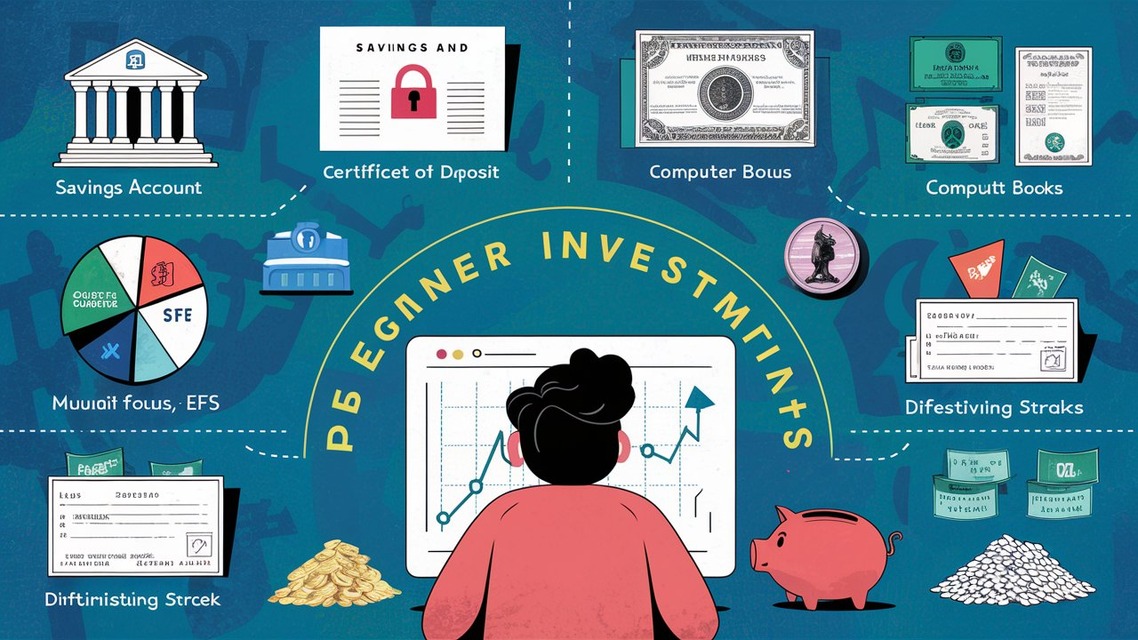Introduction
Welcome to the world of investing! If you’re new to this, it might seem overwhelming at first, but don’t worry. This guide will walk you through the basics of investing, focusing on low-risk options that are perfect for beginners. Whether you’re looking to build your wealth, save for retirement, or secure your financial future, investing is a powerful tool to help you achieve your goals.
What is Investing?
At its core, investing means putting your money into financial products or assets with the expectation of generating a profit over time. The most common types of investments include stocks, bonds, mutual funds, and real estate. The key is to find the right balance between risk and return that suits your financial goals and risk tolerance.
Download Video
Why Invest?
- Grow Your Wealth: Investments have the potential to grow your money faster than a standard savings account by leveraging the power of compound interest, market appreciation, and diversification across various asset classes. With the right strategy and a bit of patience, investments can significantly increase your wealth over time.
- Beat Inflation: Investing can help you stay ahead of inflation, ensuring your purchasing power doesn’t diminish over time. By allocating your money into various assets such as stocks, bonds, or real estate, you can potentially earn returns that outpace the rate of inflation. This not only protects your wealth but also helps it grow, providing financial security and peace of mind for the future.
- Future Security: Whether it’s for retirement, your children’s education, or a dream vacation, investing can help you reach your financial milestones. By strategically allocating your resources and taking advantage of compound interest, you can grow your wealth over time. Proper investment planning allows you to achieve your goals while securing a stable financial future for yourself and your loved ones.
Low-Risk Investment Options
For beginners, starting with low-risk investments is a smart strategy. Here are some popular low-risk options:
1. Savings Accounts and Certificates of Deposit (CDs)
- Savings Accounts: These accounts offer a safe place to keep your money while earning a small amount of interest over time. They are highly liquid, meaning you can access your money anytime without any penalties or waiting periods. This makes them an ideal option for emergency funds or short-term savings goals.
- Certificates of Deposit (CDs): CDs, or Certificates of Deposit, typically offer higher interest rates than savings accounts in exchange for locking your money away for a set period, ranging from a few months to several years. This commitment means you cannot access the funds without penalty until the CD matures. They’re also FDIC insured, up to the applicable limits, making them a very safe investment. This security is particularly appealing to risk-averse investors looking to preserve their capital while earning a steady return. Additionally, the interest rates on CDs are fixed, providing predictability in your earnings.
2. Government Bonds
- Treasury Bonds: These are issued by the U.S. government and are considered one of the safest investments due to the government’s creditworthiness. They pay a fixed interest rate over a specified period, typically ranging from a few months to several years, providing a reliable income stream for investors seeking stability and security.
- Municipal Bonds: Issued by states, cities, or other local government entities, these bonds are generally considered low-risk investments and often come with tax benefits. They are used to fund public projects such as schools, roads, and infrastructure improvements. Investors are typically drawn to these bonds due to their relative safety and the potential for tax-exempt income. Additionally, they can be an attractive option for those looking to support community development and public services.
3. Corporate Bonds
- Corporate bonds are issued by companies to raise capital, often for expansion, research, or other business activities. While slightly riskier than government bonds due to the default risk, they usually offer higher interest rates to compensate investors. To minimize risk, look for highly-rated bonds from stable companies with strong financial health and a proven track record of meeting their debt obligations. Additionally, diversifying your bond investments can further reduce potential risks.
4. Mutual Funds and Exchange-Traded Funds (ETFs)
- Mutual Funds: These are investment vehicles that pool money from many investors to purchase a diversified portfolio of stocks, bonds, or other securities. Managed by professionals who carefully select and balance the investments to maximize returns and minimize risks, these vehicles offer a way for individual investors to gain exposure to a broad range of assets without needing extensive knowledge or large amounts of capital. This professional management and diversification make them an excellent choice for beginners who are looking to invest but may not have the time, expertise, or resources to do it themselves.
- ETFs: Similar to mutual funds, ETFs (Exchange-Traded Funds) are collections of different securities such as stocks, bonds, or other assets. They trade on stock exchanges just like individual stocks, offering investors the ability to buy and sell throughout the trading day. ETFs provide diversification, which can help reduce risk, and typically come with lower fees compared to mutual funds, making them an attractive option for many investors.
5. Dividend-Paying Stocks
- These stocks belong to companies that share a portion of their profits with shareholders in the form of dividends. While stocks are generally riskier than bonds due to market volatility, dividend-paying stocks can provide a steady income and potential for growth. Investors often favor these stocks for the combination of regular income and the opportunity for capital appreciation. Moreover, companies that pay dividends are usually financially stable, which can offer an additional layer of security to investors.
Getting Started
1. Set Clear Financial Goals
Before you start investing, take the time to clearly define what you want to achieve. Are you saving for retirement, a down payment on a house, or building an emergency fund for unexpected expenses? Understanding your goals will help guide your investment strategy and ensure you stay focused on what’s important to you in the long run.
2. Determine Your Risk Tolerance
Understand how much risk you’re comfortable taking. Low-risk investments, such as savings accounts and government bonds, are generally safer but offer lower returns. On the other hand, higher-risk investments, like stocks and cryptocurrencies, come with greater potential for both substantial gains and significant losses. It’s crucial to consider your financial goals, time horizon, and risk tolerance when building your investment portfolio. Balancing different types of investments can help manage risk while striving for growth.
3. Educate Yourself
Take time to learn about different investment options and how they work. Understanding the basics of stocks, bonds, mutual funds, and real estate can help you make informed decisions. There are numerous resources available, including books written by financial experts, online courses that offer in-depth analyses, and financial news websites that keep you updated on market trends. Additionally, attending seminars or consulting with financial advisors can provide valuable insights tailored to your personal financial goals.
4. Start Small
Begin with a small amount of money that you can afford to invest without impacting your daily life. This initial sum should be an amount you’re comfortable risking, knowing it won’t affect your essential expenses or savings. Starting small will help you gain confidence and valuable experience in the world of investing, allowing you to learn the ropes, understand market dynamics, and develop your own strategies without significant financial stress. As you grow more knowledgeable and comfortable with investing, you can gradually increase your investments and explore more complex financial instruments.
5. Diversify Your Portfolio
Don’t put all your eggs in one basket. It’s important to diversify your investments across different asset classes such as stocks, bonds, real estate, and commodities to reduce risk and improve potential returns. By spreading your investments, you can protect your portfolio from market volatility and take advantage of growth opportunities in various sectors. Diversification helps in balancing potential losses and gains, ensuring a more stable financial future.
6. Seek Professional Advice
If you’re unsure where to start, consider consulting with a financial advisor. They can provide personalized guidance based on your financial situation and goals, helping you to create a comprehensive financial plan. This plan can include budgeting, saving strategies, investment advice, and retirement planning, ensuring you have a clear path to achieving your financial objectives. A financial advisor can also help you navigate complex financial products and make informed decisions, giving you peace of mind and confidence in your financial future.
Conclusion
Investing doesn’t have to be intimidating. By starting with low-risk options, setting clear goals, and educating yourself, you can build a solid foundation for your financial future. Remember, the key to successful investing is patience and consistency.
Ready to get started? Begin your investing journey today and watch your money grow over time. Happy investing!
Disclaimer
The information provided in this document is for general informational purposes only and is not intended to be financial advice. Always consult with a qualified financial advisor before making any financial decisions. The strategies and tips mentioned may not be suitable for everyone, and individual circumstances can vary. While we strive to ensure the accuracy of the information, we make no guarantees of its applicability or reliability. Use the information at your own discretion and risk.




